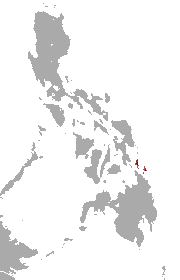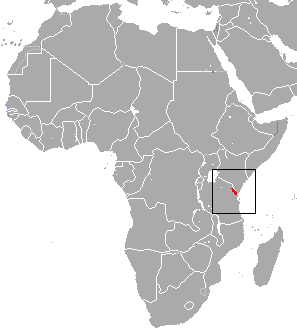
The macaques constitute a genus (Macaca) of gregarious Old World monkeys of the subfamily Cercopithecinae. The 23 species of macaques inhabit ranges throughout Asia, North Africa, and Europe. Macaques are principally frugivorous, although their diet also includes seeds, leaves, flowers, and tree bark. Some species such as the long-tailed macaque will supplement their diets with small amounts of meat from shellfish, insects, and small mammals. On average, a southern pig-tailed macaque in Malaysia eats about 70 large rats each year. All macaque social groups are arranged around dominant matriarchs.

The Negros shrew is a white-toothed shrew found only on the island of Negros in the Philippines. It is locally called the katsurí and is listed as an endangered species due to habitat loss and a restricted range.

An IUCN Red List Critically Endangered species is one that has been categorized by the International Union for Conservation of Nature as facing an extremely high risk of extinction in the wild. As of 2021, of the 120,372 species currently tracked by the IUCN, there are 8,404 species that are considered to be Critically Endangered.
The heavenly hill rat is a species of rodent in the family Muridae. It is found only in southwestern Sulawesi, Indonesia, where it has only been found on Mount Lompobatang. Its natural habitat is subtropical or tropical dry forest. It is threatened by habitat loss.

Villa's gray shrew is a shrew native to northeastern Mexico, where it is called musaraña.

The forest fody is a species of bird in the family Ploceidae. It is endemic to Madagascar.

The Somali hedgehog is a species of mammal in the family Erinaceidae. It is endemic to Somalia and Somaliland. The Somali hedgehog is nocturnal.

The Hainan gymnure or Hainan moonrat is a species of mammal in the family Erinaceidae. Its natural habitat is subtropical or tropical dry forests. It was thought to be endemic to the island of Hainan, China where it is threatened due to habitat loss, but in 2018 was found to also occur in, and be rather common, within Northern Vietnam.

The Dinagat gymnure is a species of mammal in the family Erinaceidae. It is endemic to the Philippines.

The African black shrew is a species of shrew. It is native to Africa, where it is widespread. Other common names include tenebrous shrew. This shrew can be found in several types of lower-elevation moist tropical forest habitat.

The Cameroonian shrew is a species of mammal in the family Soricidae. It is endemic to Cameroon. Its natural habitat is subtropical or tropical moist montane forests. It is threatened by habitat loss.

The Usambara shrew is a species of mammal in the family Soricidae. It is endemic to Bumbuli District of Tanga Region in Tanzania. Its natural habitat is subtropical or tropical moist montane forests of Usambara mountains.

Sclater's shrew is a species of mammal in the family Soricidae. It is endemic to Mexico.

The greater dwarf shrew is a species of mammal in the family Soricidae. It is found in Angola, Botswana, Democratic Republic of the Congo, Kenya, Malawi, Namibia, Tanzania, Zambia, and Zimbabwe. Its natural habitats are subtropical or tropical dry forests and dry savanna. It is present in several protected areas, including the Kruger National Park. The main threat to greater dwarf shrews is the loss or degradation of moist, productive areas such as wetlands and rank grasslands within suitable habitat.

Lovoa trichilioides, also called African walnut, Congowood, dibetou or tigerwood, is a species of plant in the family Meliaceae. It is found in Angola, Cameroon, the Republic of the Congo, the Democratic Republic of the Congo, Ivory Coast, Gabon, Ghana, Liberia, Nigeria, Sierra Leone, Tanzania, and Uganda. It is threatened by habitat loss. Germination success is somewhat limited by short-lived seeds which are heavily predated. Exploitation rates are high. It is one of the two principal timber species in Congo.

Metastelma is a genus of plant in the family Apocynaceae first described in 1810.
Metastelma purpurascens is a species of plant in the family Apocynaceae. It is endemic to Ecuador. Its natural habitat is subtropical or tropical moist montane forests. It is threatened by habitat loss.
Pfeiffer's red bat is a species of bat from the family Vespertilioninae and is endemic to Cuba. It is listed as Near Threatened by the IUCN Red List due to a significant population decline, caused by human population density on its endemic island, habitat conversion, and hurricanes. The species is likely insectivorous; fecal matter samples from a single bat contained only beetles. It may be a subspecies of the Seminole bat.















